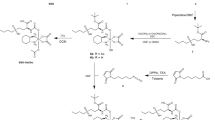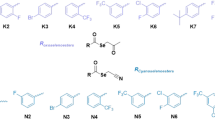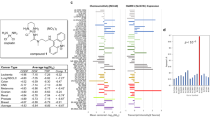Abstract
JM216 (bis-acetato ammine dichloro cyclohexylamine Pt IV) is an oral platinum complex presently undergoing phase II clinical trials. Previous studies have identified some of its biotransformation products in clinical materials. This study evaluated the nature of JM216 biotransformation products intracellularly in two different human ovarian carcinoma cell lines, one relatively sensitive to platinum agents (CH1: JM216 4 h IC50 of 5.8 microM) and the other relatively resistant (SKOV3: JM216 4 h IC50 of 60.7 microM). Metabolic profiles were also evaluated at different growth status and in cells pretreated with buthionine sulphoximine (BSO), an agent known to decrease intracellular glutathione levels. Results showed that JM216 enters the cells and that the nature and percentage of biotransformation products was dependent upon glutathione levels. Furthermore, results support the view that the previously reported peak A biotransformation product contains a glutathione adduct. In exponentially growing SKOV3 cells which contain higher glutathione levels than CH1, (82.5 vs 37.8 nmol mg-1 protein), peak A represented 89% of total platinum 4 h after JM216 exposure compared with only 24% in CH1. Moreover, 60-70% depletion of glutathione achieved by 24 h pretreatment of cells with BSO resulted in a significant decrease in peak A in both cell lines and increased the cytotoxicity of JM216 in both CH1 and SKOV3 by approximately 2-fold. Following a 4 h exposure of exponentially growing SKOV3 cells to JM216, only peak A (89%) and JM216 (11%) could be detected whereas in CH1 cells, peak A (24%), JM216 (73%) and JM118 [cis-ammine dichloro (cyclohexylamine) platinum II] (3%) were detected. However, in CH1 cells at confluence, where glutathione is lower (8 nmol mg-1 protein) four metabolites (plus JM216 itself) were detected following exposure to 50 microM JM216; peak A, JM118, JM383 (bis-acetato ammine (cyclohexylamine) dihydroxy platinum IV) and an unidentified metabolite (D), also observed in patient's plasma ultrafiltrate. In confluent SKOV3 cells exposed to 50 microM JM216, peak A, JM216 and JM118 were detected. A further unidentified metabolite observed in patients receiving JM216 (metabolite F) was not formed inside these tumour cells. Overall, these data suggest that glutathione conjugation represents a major deactivation pathway for JM216.
This is a preview of subscription content, access via your institution
Access options
Subscribe to this journal
Receive 24 print issues and online access
$259.00 per year
only $10.79 per issue
Buy this article
- Purchase on Springer Link
- Instant access to full article PDF
Prices may be subject to local taxes which are calculated during checkout
Similar content being viewed by others
Author information
Authors and Affiliations
Rights and permissions
About this article
Cite this article
Raynaud, F., Odell, D. & Kelland, L. Intracellular metabolism of the orally active platinum drug JM216: influence of glutathione levels. Br J Cancer 74, 380–386 (1996). https://doi.org/10.1038/bjc.1996.369
Issue Date:
DOI: https://doi.org/10.1038/bjc.1996.369
This article is cited by
-
Satraplatin activation by haemoglobin, cytochrome C and liver microsomes in vitro
Cancer Chemotherapy and Pharmacology (2006)
-
Novel mechanisms of platinum drug resistance identified in cells selected for resistance to JM118 the active metabolite of satraplatin
Cancer Chemotherapy and Pharmacology (2006)
-
Gene-specific repair of Pt/DNA lesions and induction of apoptosis by the oral platinum drug JM216 in three human ovarian carcinoma cell lines sensitive and resistant to cisplatin
British Journal of Cancer (1999)



